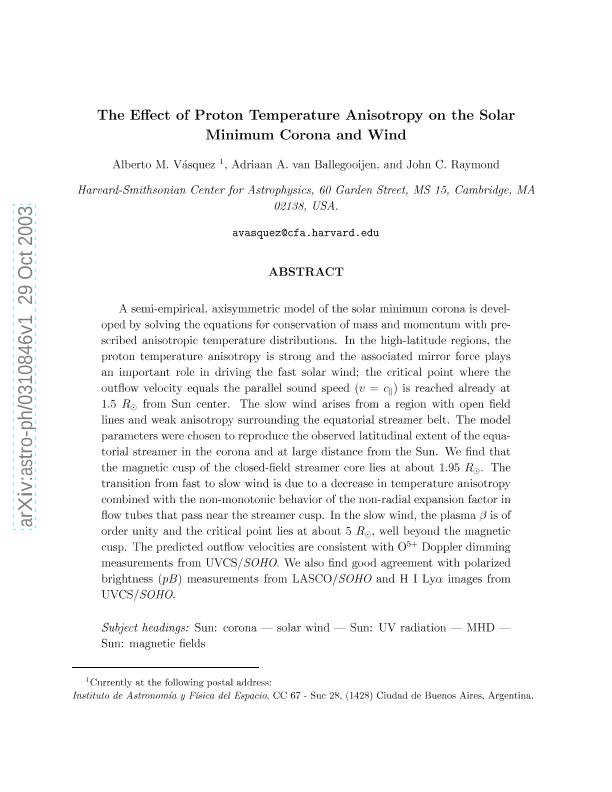Mostrar el registro sencillo del ítem
dc.contributor.author
Vasquez, Alberto Marcos

dc.contributor.author
van Ballegooijen, Adriaan A.
dc.contributor.author
Raymond, John C.
dc.date.available
2017-07-24T18:29:26Z
dc.date.issued
2003-12-01
dc.identifier.citation
Vasquez, Alberto Marcos; van Ballegooijen, Adriaan A.; Raymond, John C.; The Effect of Proton Temperature Anisotropy on the Solar Minimum Corona and Wind; IOP Publishing; Astrophysical Journal; 598; 2; 1-12-2003; 1361-1374
dc.identifier.issn
0004-637X
dc.identifier.uri
http://hdl.handle.net/11336/21178
dc.description.abstract
A semiempirical, axisymmetric model of the solar minimum corona is developed by solving the equations for conservation of mass and momentum with prescribed anisotropic temperature distributions. In the high-latitude regions, the proton temperature anisotropy is strong and the associated mirror force plays an
important role in driving the fast solar wind; the critical point where the outflow velocity equals the parallel sound speed (v ¼ ck) is reached already at 1.5 R from Sun center. The slow wind arises from a region with open-field lines and weak anisotropy surrounding the equatorial streamer belt. The model parameters were
chosen to reproduce the observed latitudinal extent of the equatorial streamer in the corona and at large distance from the Sun. We find that the magnetic cusp of the closed-field streamer core lies at about 1.95 R . The transition from fast to slow wind is due to a decrease in temperature anisotropy combined with the onmonotonic behavior of the nonradial expansion factor in flow tubes that pass near the streamer cusp. In the slow wind, the plasma is of order unity and the critical point lies at about 5 R , well beyond the magnetic cusp. The predicted outflow velocities are consistent with O5þ Doppler dimming measurements from UVCS/ SOHO. We also find good agreement with polarized brightness ( pB) measurements from LASCO/SOHO and H i Ly images from UVCS/SOHO.
dc.format
application/pdf
dc.language.iso
eng
dc.publisher
IOP Publishing

dc.rights
info:eu-repo/semantics/openAccess
dc.rights.uri
https://creativecommons.org/licenses/by-nc-sa/2.5/ar/
dc.subject.classification
Astronomía

dc.subject.classification
Ciencias Físicas

dc.subject.classification
CIENCIAS NATURALES Y EXACTAS

dc.title
The Effect of Proton Temperature Anisotropy on the Solar Minimum Corona and Wind
dc.type
info:eu-repo/semantics/article
dc.type
info:ar-repo/semantics/artículo
dc.type
info:eu-repo/semantics/publishedVersion
dc.date.updated
2017-07-24T14:12:57Z
dc.journal.volume
598
dc.journal.number
2
dc.journal.pagination
1361-1374
dc.journal.pais
Reino Unido

dc.journal.ciudad
Londres
dc.description.fil
Fil: Vasquez, Alberto Marcos. Consejo Nacional de Investigaciónes Científicas y Técnicas. Oficina de Coordinación Administrativa Ciudad Universitaria. Instituto de Astronomía y Física del Espacio. - Universidad de Buenos Aires. Facultad de Ciencias Exactas y Naturales. Instituto de Astronomía y Física del Espacio; Argentina
dc.description.fil
Fil: van Ballegooijen, Adriaan A.. Harvard-Smithsonian Center for Astrophysics; Estados Unidos
dc.description.fil
Fil: Raymond, John C.. Harvard-Smithsonian Center for Astrophysics; Estados Unidos
dc.journal.title
Astrophysical Journal

dc.relation.alternativeid
info:eu-repo/semantics/altIdentifier/url/http://iopscience.iop.org/article/10.1086/379008
dc.relation.alternativeid
info:eu-repo/semantics/altIdentifier/url/https://arxiv.org/abs/astro-ph/0310846
dc.relation.alternativeid
info:eu-repo/semantics/altIdentifier/doi/http://dx.doi.org/10.1086/379008
Archivos asociados
